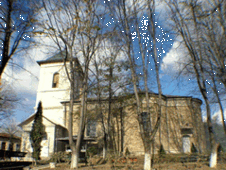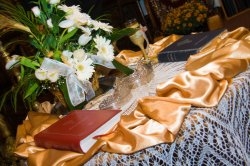The sacrament of matrimony
The sacrament of matrimony at Toma Cozma church
 „I am my beloved's.
„I am my beloved's.
And his desire is for me”.
(Song of Songs 7,11)
Toma Cozma church has two patrons, next to Saint Apostole Toma, whose name is wore by the founder, Saint Ecaterina is also praised, whose name is wore by his wife, a fact rarely met in the founding tradition, which emphasizes the respect of the founder for his wife. Concomitantly, the fact that after the untimely death of Toma Cozma, his wife Ecaterina became a nun indicates her loyalty and deep feelings that she had for her husband. /p>
 These two aspects have been noticed in the local tradition, which connected the name of the church, next to the names of the protective saints, to the image of a united and happy family, of a strong marriage which led in time to a constant interest of the young to receive the Sacrament of Matrimony in this church.
These two aspects have been noticed in the local tradition, which connected the name of the church, next to the names of the protective saints, to the image of a united and happy family, of a strong marriage which led in time to a constant interest of the young to receive the Sacrament of Matrimony in this church.
The picturesque park surrounding the church represented a strong argument in choosing this church for  receiving the Sacrament of Matrimony, and its new presentation due to the rehabilitation works turned it into an attraction point for the photo shooting of the bride and groom.
receiving the Sacrament of Matrimony, and its new presentation due to the rehabilitation works turned it into an attraction point for the photo shooting of the bride and groom.
The attendance of the parish’s Choir to the religious ceremony gives the sacred moment a beauty that enriches the love of the bride and groom with special feelings and emotions with a sensitive touch of spiritual reverberation for all the participants.
We wait for you to receive the seal of joy and solidity before the altar of our church!

 Toma Cozma Church in Iaşi, important historical monument built in 1807, on the west side of „Muntenimii” hill (later „Păcurarilor slams”) by the ban Toma Cozma and his wife Ecaterina, it has two patrons: „Saint Apostle Toma” (The main patron – celebrated on the Sunday of Toma) and „Saint Martyr Ecaterina” (The second patron – November, 25th), corresponding to the names of the two main founders of the holy dwelling. To these two founders another benefactor joined, namely Maria Apostol Anastasiu Ketreanca, the widow of a Greek descending from a monks’ family, Apostle Anastasiu, as it results from the inscription on the western wall of the church.
Toma Cozma Church in Iaşi, important historical monument built in 1807, on the west side of „Muntenimii” hill (later „Păcurarilor slams”) by the ban Toma Cozma and his wife Ecaterina, it has two patrons: „Saint Apostle Toma” (The main patron – celebrated on the Sunday of Toma) and „Saint Martyr Ecaterina” (The second patron – November, 25th), corresponding to the names of the two main founders of the holy dwelling. To these two founders another benefactor joined, namely Maria Apostol Anastasiu Ketreanca, the widow of a Greek descending from a monks’ family, Apostle Anastasiu, as it results from the inscription on the western wall of the church.